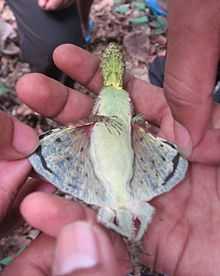Draco dussumieri
| Draco dussumieri | |
|---|---|
 | |
| Scientific classification | |
| Kingdom: | Animalia |
| Phylum: | Chordata |
| Subphylum: | Vertebrata |
| Class: | Reptilia |
| Order: | Squamata |
| Suborder: | Iguania |
| Family: | Agamidae |
| Genus: | Draco |
| Species: | D. dussumieri |
| Binomial name | |
| Draco dussumieri A.M.C. Duméril & Bibron, 1837 | |
Draco dussumieri, commonly known as the southern flying lizard, is a species of agamid lizard capable of gliding from tree to tree. It is found in the Western Ghats and hill forests of southern India.
Etymology
The specific name, dussumieri, is in honor of Jean-Jacques Dussumier, a French voyager who collected zoological specimens in southern Asia in the early 19th century.[1]
Description


When the hind leg is extended along the body, the tip reaches the axilla (armpit) of the fore limb. The nostrils open on the top of the snout and the ear opening is naked. The scales on the upper body surface are smaller than the scales of the upper lip and are slightly keeled (ridged). A horn-like, conical tubercle behind and above the posterior part of the eye is prominent. Male has a small crest arising on the nape. The gular sac on the throat is long and narrow and yellow in life. On each side of the back are small tubercular outgrowths made up of small scales. The throat has scattered, irregular brown spots. The ground-colour of the patagial wings is light yellow while blackish violet reticulated lines occupy the middle and outer half of the wings, enclosing round light spots.[2] There are 6 ribs holding up the patagium.[3][4][4] From snout to vent 95 ; tail 135 mm.
Distribution
Western Ghats and associated hill forests of Kerala, Tamil Nadu, Karnataka, Goa in southern India. It is also reported from some parts of Eastern Ghats (Talakona RF) in Andhra Pradesh [5] Nelson Annandale recorded it as "common about ten miles north of Trivandrum, but apparently very local." Often found in coconut and betel-nut plantations.[4] Jerdon noted that this species was only found in the neighbourhood of forests of the west coast of the Peninsula of India, frequenting the cocoa-nut and betel-nut plantations in this region.[2]
The Golden Oriole has been observed to capture and feed on this lizard.[6]
Notes
- ↑ Beolens B, Watkins M, Grayson M. 2011. The Eponym Dictionary of Reptiles. Baltimore: Johns Hopkins University Pres.. iii + 296 pp. ISBN 978-1-4214-0135-5. (Draco dussumieri, p. 78).
- ↑ 2.0 2.1 Günther ACLG. (1864). The Reptiles of British India. London: The Ray Society. (Taylor and Francis, printers). xxvi + 452 pp. + Plates I- XXVI. (Draco dussumieri, pp. 125-126 + Plate XIII, Figure D).
- ↑ Boulenger GA. (1890). The Fauna of British India, Including Ceylon and Burma. Reptilia and Batrachia. London: Secretary of State for India in Council. (Taylor and Francis, printers). xviii + 541 pp. (Draco dussumieri, p. 113).
- ↑ 4.0 4.1 4.2 Smith MA. (1943). The Fauna of British India, Including Ceylon and Burma. Reptilia and Amphibia, Vol. II.—Sauria. London: Secretary of State for India in Council. (Taylor and Francis, printers). xiii + 440 pp. + Plate I. (Draco dussumieri, p. 143).
- ↑ Balachandran S, Pittie A. (2000). "Occurrence of Draco or flying lizard Draco dussumieri in Chittoor, Andhra Pradesh". J. Bombay Nat. Hist. Soc. 97 (1): 147–148.
- ↑ Balachandran S. (1998). "Golden oriole Oriolus oriolus preying on flying lizard Draco dussumieri Duméril & Bibron". J. Bombay Nat. Hist. Soc. 95 (1): 115.
Other references
- Das I. 2002. A Photographic Guide to Snakes and Other Reptiles of India. Sanibel Island, Florida: Ralph Curtis Books. 144 pp. ISBN 0-88359-056-5. (Draco dussumieri, p. 75).
- Duméril AMC, Bibron G. (1837). Erpétologie Générale ou Histoire Naturelle Complète des Reptiles. Tome quatrième. [Vol. 4]. Paris: Librairie Encyclopédique de Roret. ii + 571 pp. (Draco dussumieri, pp. 456-458).
- Honda, Masanao; Ota, Hidetoshi; Kobayashi, Mari; Nabhitabhata, Jarujin; Yong, Soi-Sen; Hikida, Tsutomu. (1999). "Phylogenetic relationships of the flying lizards, genus Draco (Reptilia: Agamidae)". Zoological Science 16: 535-549.
- Inger RF. (1983). "Morphological and ecological variation in the flying lizards (genus Draco)". Fieldiana Zoology, New Series (18): vi + 1-35.
- McGuire, Jimmy A.; Heang, Kiew Bong. (2001). "Phylogenetic systematics of Southeast Asian flying lizards (Iguania: Agamidae: Draco) as inferred from mitochondrial DNA sequence data". Biological Journal of the Linnean Society 72: 203-229.
- Murthy TSN. (1990). "A field book of the lizards of India". Rec. Zool. Surv. India 115: 1-122.